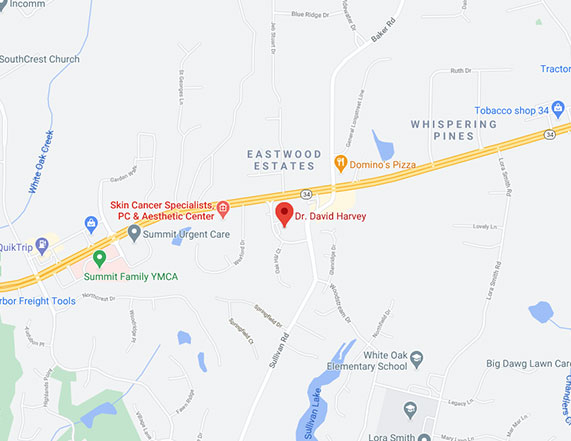Conveniently located to serve Newnan, Peachtree City and LaGrange
Click here to jump to:
Newnan Squamous Cell Carcinoma
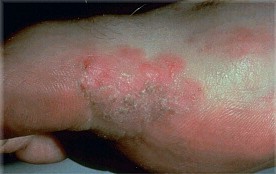
Fig. 1 Squamous Cell Cancer – scaling non healing lesion on the foot
WHAT IS SQUAMOUS CELL CANCER?
Squamous Cell Carcinoma is the second most common type of skin cancer in the world today. In 2012, over 700, 000 cases of squamous cell carcinoma are estimated to occur annually in the United States. Thankfully, this form of skin cancer is readily curable in most instances. Squamous cell carcinoma can arise as a result of chronic sun exposure, tobacco use or a predisposed genetic susceptibility. Those patients with blue eyes and freckles, who burn easily, or who have a history of blistering sunburns are more likely to develop this type of skin cancer. In some instances, squamous cell cancer arises without symptoms. For these reasons, complete skin checks should be performed by your dermatologist annually. Once a diagnosis of squamous cell carcinoma is made, there is up to a 50% chance of your developing a second similar cancer within 5 years.
HOW DO I RECOGNIZE SQUAMOUS CELL CANCER?
Squamous cell carcinoma can present itself in a multitude of ways. Often a non-healing lesion is the earliest sign. Bleeding, pain, tingling, ulceration and itching can also be early symptoms. Squamous cell carcinoma can appear as a red bump or a scaly patch. Typically, this form of cancer occurs on sun exposed sites such as the rim of the ear, or nose. Unlike basal cell carcinoma, the most common form of skin cancer, Squamous cell carcinoma can metastasize internally. When a tumor is noted on the lip or mucous membrane region, the risk for internal spread is greater. If a non-healing sore occurs as described above, it is advisable to have us assess the lesion as soon as possible.
HOW DO I KNOW IF THIS FORM OF CANCER HAS SPREAD INTERNALLY?
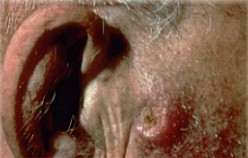
Fig. 2 SCC near the ear … a high risk area
Many times when cancer has spread internally or “metastasized”, the patient may develop swelling of lymph node glands around the primary cancer site. Symptoms such as cough, persistent headaches or shortness of breath can also suggest that the cancer may have spread internally. It is important to refrain from smoking or chewing tobacco as these habits can potentate squamous cell carcinoma development. If you develop similar symptoms it is important to have a thorough examination by your doctor.
RISK FACTORS FOR DEVELOPING SQUAMOUS CELL CARCINOMA
- Personal and family history of Skin Cancer
- History of Blistering sunburns
- Fair skin
- History of Blue or Green eyes
- History of Freckles
- History of chronic sun damage
- Exposure to hydrocarbons (soot, pipe-smoking)
- Old age
Related
Content
Patient
Review
“Very warm and friendly environment, I did not feel rushed.”
by Anonymous
HOW CAN I PREVENT SQUAMOUS CELL CANCER FROM AFFECTING ME OR MY CHILDREN?
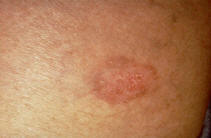
Fig. 3 Squamous Cell Cancer early stage
Education is the key to prevention. A significant amount of sun exposure occurs before the age of 20. Therefore, it is important to learn some smart skin habits early in life. These include such things as:
- Avoiding intense sun exposure between the hours of 10 AM and 4 PM (a good rule of thumb is to avoid the sun when your shadow is shorter than your actual height).
- Apply a sunscreen with a SPF of at least 30 that is broad spectrum and sweat resistant (especially if you are exercising or working outdoors).
- Reapplying your sunscreens every 40 to 80 minutes as the sunscreen label indicates.
- Wearing densely woven protective clothing, (e.g. Coolibar™).
- Performing self examinations every 3 months.
- Have an annual skin examination performed by your dermatologist.
- Familiarize yourself with the early signs of squamous cell cancer as described previously.
WHAT ARE SOME OF THE OPTIONS FOR TREATMENT OF SQUAMOUS CELL CANCER?
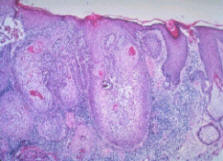
Fig. 4 Squamous Cell Cancer Microscopic view
The mainstay therapy for Squamous Cell Cancer involves surgical removal. Cold liquid nitrogen spray can also yield high cure rates in certain instances. Many of these procedures are performed under local anesthesia and recovery time is rapid. In cases where cancer is impinging on a vital area such as on the nose or eye, a technique called Mohs Surgery may be employed.
Mohs surgery involves the evaluation of multiple frozen specimens to make sure that these “danger areas” are free from residual tumor. Other options for treatment include a “Slow Mohs” procedure in which the cancer is initially removed, the defect left bandaged and the area repaired 48 hours later. This option has an advantage over standard Mohs Surgery in that permanent sections are utilized to assess tumor margins. The added 24 to 48 hour period of healing can often make the surgical repair process much easier. When internal spread has occurred, treatment with intravenous chemotherapy is begun and a cancer specialist is consulted. Remember to let us know if you develop a non-healing sore of the mouth or mucous membrane region and learn to become familiar with the early signs of skin cancer development.
NEW TREATMENTS FOR SQUAMOUS CELL CANCER
For early and limited Squamous Cell Cancer, Aldara™ cream can be used to eliminate the cancer. This saves patients from surgery and leads to an excellent cosmetic result. For more information about Aldara™ nonsurgical treatments, please inquire about this at your next appointment.
For more information on Squamous Cell Carcinoma or to set up a consultation, click here. Thank you and we look forward to helping you.










